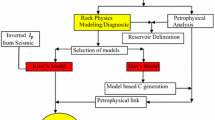Abstract
Characterization of a reservoir model requires determination of its petrophysical parameters, such as porosity and saturation. We propose a new method to determine these parameters directly from seismic data. The method consists of the computation and inversion of seismic waveforms. A high frequency method is presented to model wave propagation through an attenuative and dispersive poroelastic medium. The high frequency approximation makes it possible to efficiently compute sensitivity functions. This enables the inversion of seismic waveforms for porosity and saturation. The waveform inversion algorithm is applied to two laboratory crosswell datasets of a water saturated sand. The starting models were obtained using travel time tomography. The first dataset is inverted for porosity. The misfit reduction for this dataset is approximately 50%. The second dataset was obtained after injection of a nonaqueous-phase liquid (NAPL), possibly with some air, which made the medium more heterogeneous. This dataset was inverted for NAPL and air saturation using the porosity model obtained from the first inversion. The misfit reduction of the second experiment was 70%. Regions of high NAPL and high air saturation were found at the same location. These areas correlate well with the position of one of the injection points as well as regions of higher NAPL concentrations found after excavation of the sand. It is therefore possible to directly invert waveforms for pore fluid saturation by taking into account the attenuation and dispersion caused by the poroelasticity.
Similar content being viewed by others
References
Amodei D., Keers H., Vasco D. and Johnson L., 2006. Computation of uniform wave forms using complex rays. Phys. Rev. E, 73, 036704.
Berryman J.G., 1980. Long-wavelength propagation in composite elastic media I. Spherical inclusions. J. Acoust. Soc. Am., 69, 1809–1819.
Biot M.A., 1962. Mechanics of deformation and acoustic propagation in porous media. J. Appl. Phys., 33, 1482–1498.
Červený S., 2001. Seismic Ray Theory. Cambridge University Press, Cambridge, UK.
Chapman C.H., 2004. Fundamentals of Seismic Wave Propagation. Cambridge University Press, Cambridge, UK.
Dvorkin J. and Nur A., 1993. Dynamic poroelasticity: A unified model with the squirt and the Biot mechanisms. Geophysics, 58, 525–533.
Gassmann F., 1951. Über die Elastizität elastischer Medien. Vierteljahresschrift der Naturforschenden Gesellschaft Zürich (About the elasticity of elastic media. Quarterly Journal of the Society for Natural Sciences, Zürich), 96, 1–21.
Geller J.T., Kowalsky M.B., Seifert P.K. and Nihei K.T., 2000. Acoustic detection of immiscible liquids in sand. Geoph. Res. Lett., 27, 417–420.
Guéguen Y. and Palciauskas V., 1994. Introduction to the Physics of Rocks. Princeton University Press, Princeton, USA.
Haddon R.A.W. and Buchen P.W., 1981. Use of Kirchhoff’s formula for body wave calculations in the Earth. Geoph. J. R. astr. Soc., 67, 587–598.
Kaelin B. and Johnson L.R., 1998. Dynamic composity elastic medium theory. Part II. Three-dimensional media. J. Appl. Phys., 84, 5458–5468.
Keers H., Johnson L. and Vasco D., 2000. Acoustic crosswell imaging of asymptotic waveforms. Geophysics, 65, 1569–1582.
Keers H., Vasco D. and Johnson L., 2001. Viscoacoustic crosswell imaging using asymptotic waveforms. Geophysics, 66, 861–870.
Korneev V.A. and Johnson L.R., 1993. Scattering of elastic waves by a spherical inclusion, I, Theory and numerical results. Geoph. J. Int., 115, 251–263.
Kravtsov Y.A. and Orlov Y.I., 1990. Geometrical Optics of Inhomogeneous Media. Springer-Verlag, Berlin, Germany.
Kuster G. and Toksöz M., 1974. Velocity and attenuation of seismic waves in two-phase media: Part I. theoretical formulations. Geophysics, 39, 587–606.
Mavko G., Mukerji T. and Dvorkin J., 1998. The Rock Physics Handbook. Cambridge University Press, Cambridge, UK.
Moczo P., Bard P.-Y. and Pšenčík I., 1987. Seismic response of two-dimensional absorbing structures by the ray method. J. Geophys., 62, 38–49.
Paige C.C. and Saunders M.A., 1982. LSQR, an algorithm for sparse linear equations and sparse least squares. ACM Trans. Math. Software, 8, 43–71.
Seifert P., Geller J.T. and Johnson L.R., 1998. Effect of P-wave scattering on velocity and attenuation in unconsolidated sand saturated with immiscible liquids. Geophysics, 63, 161–170.
van der Sluis A. and van der Vorst H.A., 1987. Numerical solution of large, sparse linear algebraic systems arising from tomographic problems. In: G. Nolet (Ed.), Seismic Tomography. Reidel, Dordrecht, The Netherlands, 49–83.
Snieder R. and Sambridge M., 1992. Ray perturbation theory for travel times and ray paths in 3-D heterogeneous media. Geophys. J. Int., 109, 294–322.
Vasco D.W., Peterson J.E. and Majer E.L., 1996. A simultaneous inversion of seismic travel times and amplitudes for velocity and attenuation. Geophysics, 61, 1738–1757.
Virieux J., 1991. Fast and accurate ray tracing by Hamiltonian perturbation. J. Geophys. Res., 96, 579–594.
Author information
Authors and Affiliations
Rights and permissions
About this article
Cite this article
Keers, H., Johnson, L. & Vasco, D. Determination of porosity and saturation using seismic waveform inversion. Stud Geophys Geod 51, 119–140 (2007). https://doi.org/10.1007/s11200-007-0006-7
Received:
Revised:
Accepted:
Issue Date:
DOI: https://doi.org/10.1007/s11200-007-0006-7




